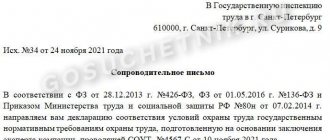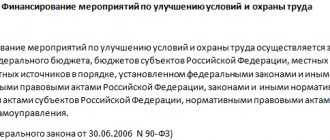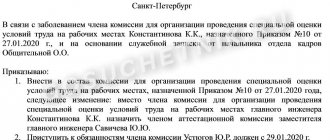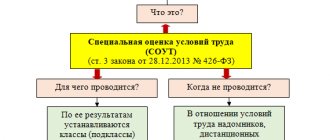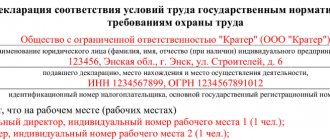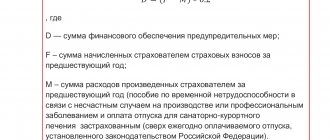What is a special assessment of working conditions
This is a set of measures, the purpose of which is to establish the presence of harmful factors in each workplace and assign it a risk class.
This is stated in Article 1 of the Federal Law of December 28, 2013 No. 426-FZ “On Special Assessment of Working Conditions” (hereinafter referred to as the Law on SOUT). There are four risk classes:
- Optimal (1.0): dangerous and (or) harmful production factors are either completely absent or are at a level that is safe for humans. The prerequisites have been created to maintain a high level of performance.
- Acceptable (2.0): there are dangerous and (or) harmful factors, but their impact does not exceed the levels established by hygiene standards. The altered functional state of the body is restored during rest, at the beginning of the next working day or shift.
- Harmful (3.0): levels of exposure to negative factors exceed the standard. It is divided into subclasses: first degree (3.1), second degree (3.2), third degree (3.3) and fourth degree (3.4).
- Dangerous (4.0): levels of exposure to negative production factors can create a threat to the life of an employee, and the consequences can lead to the development of an occupational disease.
The results of the SOUT are used, among other things, when assigning discounts and surcharges to the rate of contributions “for injuries” and additional tariffs for pension contributions. Employees who work in workplaces classified as hazardous (subclasses 3.2, 3.3 and 3.4) or hazardous classes are granted additional leave (Article 117 of the Labor Code of the Russian Federation). For classes 3.0 and 4.0, a salary increase of at least 4% of the salary or rate is provided (Article 147 of the Labor Code of the Russian Federation). There are other benefits as well.
Calculate “complex” wages under different remuneration systems
What is important to know about the special assessment of working conditions for small businesses and individual entrepreneurs
According to the clarification of the Ministry of Labor dated January 16, 2022, a special assessment of working conditions is carried out for ALL employers. However, individual entrepreneurs should not carry it out if:
- Individual entrepreneurs have no employees.
- Individual entrepreneurs attract specialists on an outsourcing basis and they do not have permanent jobs.
If it is still necessary to undergo a special assessment of labor conditions (there are employees on staff), then in relation to workplaces in which harmful and (or) dangerous production factors have not been identified based on the results of a special assessment of working conditions, the employer will report to the State Labor Inspectorate of the constituent entity of the Russian Federation (at the location its location) a declaration is submitted. The validity period of the submitted declaration is 10 years, provided that there is no industrial accident, occupational disease or violations identified by the State Labor Inspectorate of a constituent entity of the Russian Federation at the declared workplace. The declaration can be submitted remotely on the Rostrud website.
For new jobs created in 2022, the period for conducting a special assessment of working conditions is 12 months. For example, if a workplace was created in December 2022, then the deadline for completing a special assessment of working conditions is December 2019.
Who may not conduct an assessment of working conditions
SOUT is not mandatory for the following categories:
- organizations and individual entrepreneurs who have not concluded a single employment contract;
- employers - individuals without individual entrepreneur status;
- employers - religious organizations.
All employers, without exception, have the right to refuse SOUT in relation to the workplaces of homeworkers and remote workers (Part 3 of Art. Law on SOUT).
ATTENTION. Vacant positions are not subject to special assessment. The fact is that in the absence of employees, it is impossible to analyze their working conditions.
Who conducts a special assessment of working conditions
SOUT is carried out by a specialized third-party company with the participation of a commission created by the employer.
The commission includes: representatives of the employer and trade union organization (if it is created at the enterprise), an occupational safety specialist (see “How to become an occupational safety specialist”). It also needs to include the head of a small enterprise or individual entrepreneur. The head of the commission is appointed by the employer himself or his representative.
Compose HR documents using ready-made templates for free
The specialized third party company must meet the following criteria:
- SOUT is its main activity.
- The appropriate accreditation has been obtained.
- The staff includes at least 5 experts who have a certificate to perform special assessment work. At least one expert is a doctor in general hygiene (or occupational hygiene) or a doctor in sanitary-hygienic laboratory research.
- There is a testing laboratory accredited to measure harmful and dangerous factors in the production environment and the labor process.
Procedure for carrying out SOUT
Before starting the procedure, it is necessary to draw up a work schedule and a list of jobs that are subject to a special assessment. The form of these documents is free.
REFERENCE. SOUT is carried out in relation to the workplace, not the position. Therefore, if one person combines several positions at once, then you need to check how many jobs he actually occupies. And include each one in the list.
Further research is carried out within the framework of SOUT. Based on their results, a report is compiled. It is signed by specialists from an accredited third-party organization and members of the commission. At the same time, a card is filled out for each workplace (report forms and cards approved by order of the Ministry of Labor dated January 24, 2014 No. 33n). Employees should be familiarized with the card against signature within 30 calendar days from the date of approval of the report. Within the same period, summary data of the special assessment must be published on the employer’s official website (if available).
In addition, a declaration of compliance with working conditions is drawn up (the form and procedure for submission approved by order of the Ministry of Labor dated 02/07/14 No. 80n). It includes information about workplaces where harmful and dangerous production factors have not been identified, and working conditions are recognized as optimal and acceptable. The declaration must be submitted to the territorial labor inspectorate no later than 30 working days after approval of the report based on the results of the special labor inspection. The declaration can be submitted online on the Rostrud website. To do this, it must be signed with a qualified electronic signature.
Receive an enhanced qualified electronic signature certificate in an hour
Schedule of special assessment of working conditions (SOUT)
“APPROVED” General Director of Graphic Graphics LLC __________ Andropov A.A. "__" ________ 20__
Schedule of special assessment of working conditions (SOUT)
| № p/p | Stages of work | Responsible | Deadlines |
| 1. | Meeting of the commission for conducting SOUT, distribution of functions. | Commission (clause 5 of article 9 426-FZ) | 10.01.19 |
| 2. | Preparation and approval of a list of workplaces at which SOUT will be carried out, indicating similar workplaces. Preparation of materials, certificates and other documentation for the performing organization for each workplace and the organization as a whole. | Commission (clause 5 of article 9 426-FZ) | From 10.01.19 to 15.01.19 |
| 3. | Determination of the organization that will perform the work on carrying out the special assessment system and preparation for the conclusion of a civil law contract for the designated management system. | Occupational Safety Specialist | From 15.01.19 to 01.02.19 |
| 4. | Identification of potentially harmful and (or) dangerous production factors by experts of the selected implementing organization. | Expert of the organization conducting SOUT (Clause 2 of Article 10 426-FZ) | Within 10 days from the date of conclusion of the contract |
| 5. | Conducting research (measurements) of harmful and (or) hazardous production factors by experts from the implementing organization. | Organization conducting SOUT (Clause 6 of Article 12 426-FZ) | Within 20 days from the date of conclusion of the contract |
| 6. | Conducting an assessment of the research conducted, assessing the effectiveness of the use of personal protective equipment (if necessary). Receipt of the final set of documents for approval by the commission. | Organization conducting SOUT (Clause 6 of Article 12 426-FZ) | Within 30 days from the date of conclusion of the contract |
| 7. | Review and approval of a report on a special assessment of working conditions. | Commission (clause 5 of article 9 426-FZ) | 5 days |
| 8. | Sending a Notification to the organization that carried out the special assessment of labor conditions on the day of approval of the report on the special assessment of working conditions. | Commission (clause 5 of article 9 426-FZ) | within 3 days from the date of approval of the report |
| 9. | Familiarization of workers with the results of a special assessment of working conditions. | Commission (clause 5 of article 15 426-FZ) | Within 30 calendar days from the date of approval of the report |
| 10. | Submitting a Declaration of Compliance of Working Conditions with State Regulatory Labor Safety Requirements | Commission (Clause 1 of Article 11 426-FZ) | Within 30 working days from the date of approval of the report |
| 11. | Posting summary data on the results of a special assessment of working conditions on the official website on the Internet information and telecommunications network | Responsible for publishing materials on the organization’s website (clause 6 of Article 15 426-FZ) | Within 30 calendar days from the date of approval of the report |
The schedule was compiled on “__” ________ 20__.
Chairman of the commission: position signature full name
Download the Schedule of Special Assessment of Working Conditions form .doc
The schedule was prepared on the basis of clause 1 of Article 9 of Law 426-FZ
Article 9. Preparation for a special assessment of working conditions.
1. To organize and conduct a special assessment of working conditions, the employer forms a commission to conduct a special assessment of working conditions (hereinafter referred to as the commission), the number of members of which must be odd, and a schedule for conducting a special assessment of working conditions is approved.
Timing and frequency of carrying out SOUT
The last stage of the special assessment was completed by January 1, 2019 (Part 6 of Art. Law on SOUT). It is assumed that by this date all employers have carried out the above activities and submitted the declaration on time.
When should the next SOUT procedure be scheduled? If there are no industrial accidents or occupational diseases, and inspectors do not find violations in the field of labor protection, there is no need to do a second special assessment. And only upon the occurrence of one of these events, it is necessary to carry out an unscheduled assessment of labor conditions and re-submit the declaration (see “The declaration of special assessment of working conditions was made indefinite”).
IMPORTANT. When a new workplace appears, it is necessary to organize an unscheduled special assessment. This must be done within 12 months from the date it was put into operation.
Timing and frequency of special assessment of SOUT workplaces
The SOUT declaration is unlimited
The declaration of SOUT (compliance of working conditions) with state regulatory labor protection requirements is valid indefinitely ONLY if working conditions at the relevant workplace are maintained and there are no accidents there (from 2022). Previously, the Declaration of Conformity of Working Conditions with State Regulatory Labor Safety Requirements for Specialized Labor Safety was valid for 5 (five) years and, after this time, was extended for another 5 years if working conditions were maintained and there were no accidents at the relevant workplace.
The start date of the SOUT is calculated from the date of posting the approved report on the special assessment of working conditions by SOUT specialists in the FSIS (Federal State Information System of Accounting) of the results of the special assessment of working conditions. Specialists from SOUT are obliged to officially inform the department about the date of placement no later than 3 (three) working days from the date of placement. Until 2022, the validity period of the declaration was calculated from the date of approval of the report for a special assessment of working conditions.
The declaration ceases to be valid
The declaration will cease to be valid if:
- the employee was diagnosed with an occupational disease;
- there was an accident at work;
- the GIT inspector identified violations against the employee or at his workplace.
In these cases, there is a need to conduct an unscheduled special assessment of working conditions. An unscheduled special assessment can be carried out in other cases (Article 17 of Law No. 426). The period for conducting an unscheduled assessment is determined by 6 months from the date of occurrence of the above cases.
The cost of the special assessment and who pays for it
The law does not regulate the cost of the procedure. The price depends on a number of factors: market conditions, size of the organization, number of staff, etc. On average, SOUT for one place costs from 600 rubles. Most accredited companies have set a lower price threshold: even if a special assessment needs to be carried out for a small number of jobs, for example, one or two, you will have to pay at least 10,000 rubles for the procedure.
As a general rule, the employer must finance the entire range of measures for a special assessment of working conditions. But he can reimburse a certain amount through contributions for insurance against industrial accidents and occupational diseases. It is permissible to direct part of such contributions to the prevention of injuries and occupational diseases, including to the SOUT (see “The procedure for reimbursement of expenses for the reduction of injuries and occupational diseases has been changed”).
According to what laws should SOUT be carried out?
Of course, there are many government regulations on this issue. However, today we will note the four most important ones. So, “SOUT” What is this in labor protection? What documents should be followed when organizing this procedure?
- Labor Code of the Russian Federation dated December 30, 2001 No. 197-FZ;
- Federal Law “On Special Assessment of Working Conditions” dated December 28, 2013 No. 426-FZ;
- Order of the Ministry of Labor of Russia dated January 24, 2014 No. 33n (as amended on November 14, 2016) “On approval of the Methodology for conducting a special assessment of working conditions, the Classifier of harmful and (or) hazardous production factors, the report form for a special assessment of working conditions and instructions for filling it out ";
- Code of the Russian Federation on Administrative Offenses dated December 30, 2001 No. 195-FZ;
Organizations conducting special assessments must have an accredited testing laboratory. This is evidenced by a special accreditation certificate.
The Labor Code establishes the need for a special assessment of working conditions. Pay attention to Article 212. The Federal Law on SOUT (the one No. 426-FZ) tells how to organize the procedure itself. And Method 33 establishes the procedure for carrying out measurements and recording and presenting the results.
